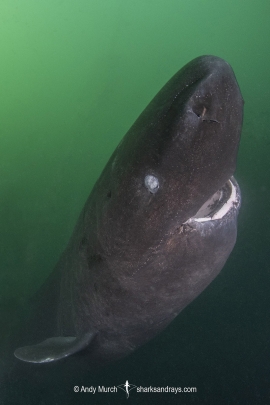
Unlike other shark species, the liver of the Pacific Sleeper shark (Somniosus pacificus) does not contain squalane, a lipid commonly found in sharks' livers that helps control their buoyancy.
(Bakes et al., 1995)
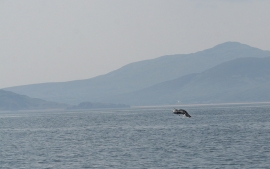
Basking sharks will breach (e.g. jump out of the water). It is unknown why they do this, but they can breach at speeds comparable to those of white sharks ambushing seals/sea lions.
(Johnston et al., 2019)
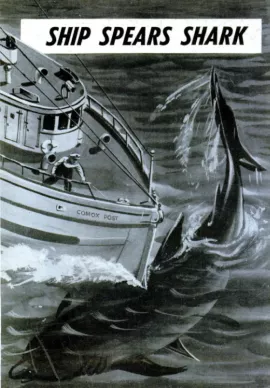
Basking sharks used to be so abundant along the west coast of North America as to be considered a pest species, because they were consistently entangled in fishing nets. Now, sightings in this region are rare, largely due to a designated eradication program and targeted fishing efforts in the mid-20th century
(McInturf et al., 2022)
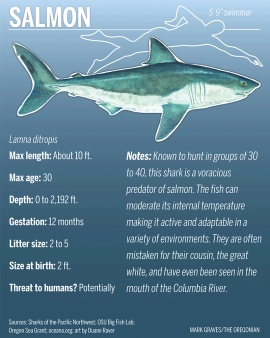
Salmon sharks can reach lengths of over 10 ft and weights of almost 1000lbs.
(Florida Museum of Natural History)
The Dwarf Lantern shark (Etmopterus perryi) earns its name by its ability to "glow" using photophores, organs that can emit light, along the bottom of its body. Their light up belly serves dual purposes, when in deeper waters with low light their belly will attract prey but in shallower, lighter waters the belly acts as camoflauge to hide them from the predators beneath them
(Smithosian Institute )
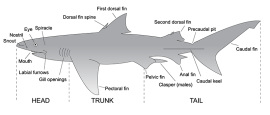
All elasmobranchs share something in common. Unlike other fish, they have no swim bladder and their skeletons are made of cartilage, not bone!
(Fange, 1966; Shuttleworth, 2012)
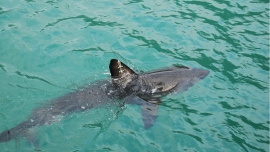
Tag and catch data suggest that salmon sharks exhibit "sexual segregation" in the Pacific, with females dominating the Northeast (up near Alaska) and males in the Northwest (Japan, Russia, Bering Sea)
(Goldman and Musick, 2006))
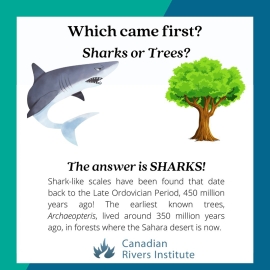
The earliest evidence of shark fossils dates back as far as 450 million years, which means they have been around at least 90 million years before trees and 190 million years before the dinosaurs.

Sevengill sharks are capable of "spy hopping," a behavior where animals elevate their head out above the water. This behavior is thought to help in prey detection.
(Ebert 1991)

Salmon sharks are found only in the Northern Pacific Ocean.
(Goldman and Musick, 2008)
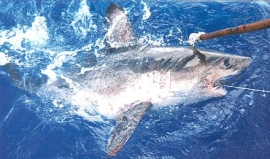
While salmon sharks are often said to pose a threat to humans, no salmon shark has ever been implicated in a shark attack.
(International Shark Attack File)
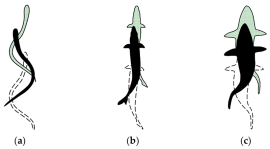
Salmon sharks have a thunniform body shape characteristic of other fast and highly migratory fish. This means that most of the propulsion used to swim at these high speeds takes place in the caudal fin.
(Goldman and Musick, 2008)

Leopard sharks (Triakis semifasciata) movements are related to the tides, during high tides they move to shallower water to hunt. As the tide goes out they tend to move towards deeper water hanging out in kelp forests and rocky reefs
(Smith, 2001 )
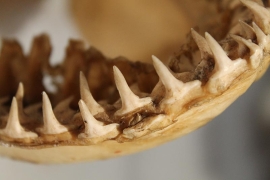
Sharks have not just one row of teeth, but several. They constantly lose and replace these teeth and it has been proposed that frequency of tooth replacement is due to stress and wear on the tooth, not tooth failure.
(Whitenack et al., 2011)
According to the IUCN, broadnose sevengill have experienced an estimated global population reduction of 30-49% over just three generations due to high levels of exploitation across the species’ range.
("Jaureguizar AJ, Cortés F, Braccini JM, Wiff R, Milessi AC (2021) Growth estimates of young- of-the-year broadnose sevengill shark, Notorynchus cepedianus, a top predator with poorly calcified vertebrae. Journal of Fish Biology")
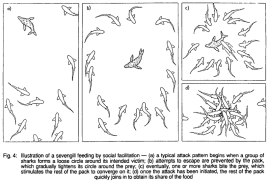
Sevengill sharks hunt in packs to take down larger prey.
(Ebert 1991)
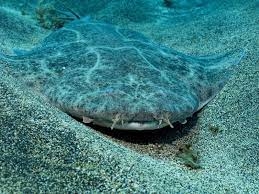
The Pacific Angel shark (Squatina californica) is recognizable by its flat appearance and sandy camoflauged body. Their distinct body makes them the perfect ambush predator as they lie on the sandy bottom and wait for prey to pass by.
(Compagno 1984)
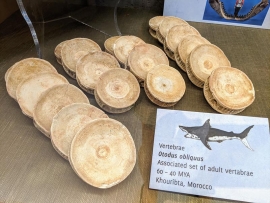
Shark vertebrae are made of calcified cartilage, which allows us to age the shark by "counting the rings"!
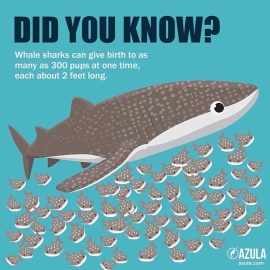
Whale sharks can give birth to up to 300 pups at once.
(Galapagos Whale Shark Project)
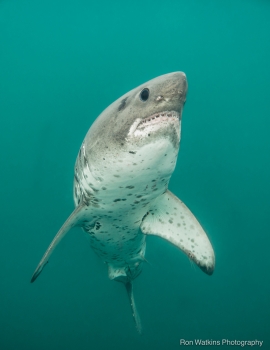
We often refer to salmon sharks as "fun-sized white sharks". The two are closely related, but salmon sharks are quite a bit smaller (only 6-10 feet in length), with tell-tale speckles on their body
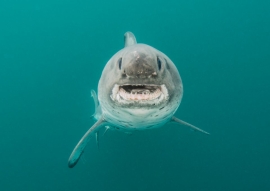
Salmon sharks (Lamna ditropis) give birth to litters of 4-5 pups
(Nagasawa, 1998)
The scientific name for salmon shark is lamna ditropis. Translated from Greek, "lamna" means voracious fish and "di" means two while "tropis" means keel in ditropis.
(Florida Museum of Natural History)
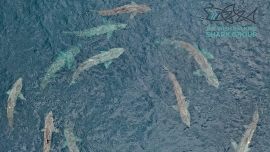
Basking sharks will exhibit a "torus" in surface waters, a giant circling group that is thought to be part of their courtship.
(Sims et al., 2023)
Salmon sharks face threats due to bycatch in trawl, gill-net, and seine fisheries and from recreational fisheries.
(Goldman and Musick, 2008)
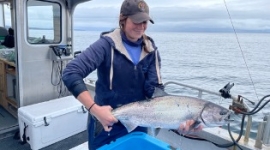
Is the name salmon shark a misnomer? Salmon sharks were so named because of their apparent consumption of salmon at river mouths; however, our lab is finding that they do not appear to specialize on salmon. Rather, they consume many species, including hake and squid.
Salmon sharks are the largest apex predator among fish in the epipelagic zone of subarctic and temperate North Pacific waters
(Goldman and Musick, 2008)
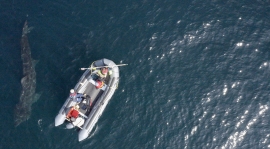
All of the world's largest sharks are filter-feeders (e.g. they feed on plankton). These include the whale shark, basking shark, and megamouth shark, all of which can reach the size of a small school bus
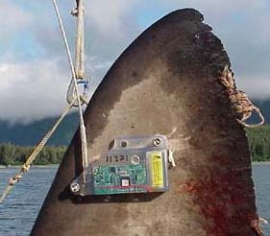
Despite a marked sexual segregation between populations tagging data has indicated that the Salmon sharks (Lamna ditropis) migrate between subartic and subtropical regions in the Pacific and have dramatic vertical movements within the water column as well
(Weng et al., 2005)

The salmon shark was orginally thought to be the same as the porbeagle shark before they were recognized as two genetically separate species. The salmon shark can be distinguished from the porbeagle by its shorter snout and dark blotched underbelly.
(Hubbs and Follet,1947)
The Goblin shark has the fastest bite of any vertebrate species at 0.319 seconds with its jaws reaching a top speed of 3.1 m/s-1.
(Nakaya et al., 2016)
Trophically, Soupfin Sharks are the 4th highest shark predator in the Northeast Pacific, ahead of Mako and Salmon sharks
(Bizzarro et al., 2017)
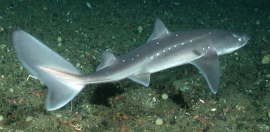
Spiny dogfish in the Northeast Pacific are among the slowest growing and longest living (80-100 years old) of all elasmobranchs, with a gestation period of 22-24 months
(Gertseva et al., 2021; Tribuzio et al., 2005)
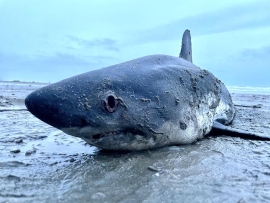
Recent studies suggest that sharks and rays are among the most threatened groups of vertebrates, with over 70% of oceanic species and 2/3 of all reef-species in decline
(Pacoureau et al., 2023; Sherman et al. 2023)
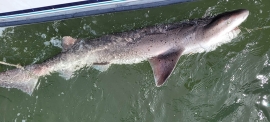
Unlike most sharks which have 5 gill slits, sevengills have 7! This is thought to be because they are such an old species.
(just look at em)
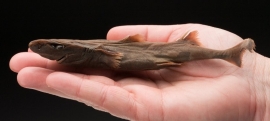
The Dwarf Lantern shark (Etmopterus perryi) is currently the smallest known living shark species.
(Springer & Burgess, 1985)
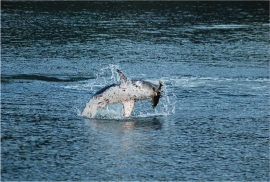
In Alaska, salmon sharks have been estimated to take 12-25% of the total annual run of Pacific salmon
(Nagasawa, 1998)
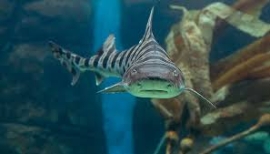
Leopard sharks (Triakis semifasciata) give birth to live young with litters of between 7-36 pups
(Smith, 2001 )
Salmon shark populations are currently stable according to the IUCN Redlist.
(IUCN Redlist)

Similar to humans, Salmon sharks (Lamna ditropis) have a 9 month gestation period
(Goldman, 2002)
Soupfin Sharks are critically endangered on the IUCN red list, because of overfishing and habitat degradation.
(Walker et al., 2020)

Sevengills are known to inhabit waters less than 200 m deep (Ebert 1996; Barnett et al. 2012) but have been recorded as deep as 360 m in Tasmania (Stehfest et al. 2014).
(Ebert DA (1996) Biology of the sevengill shark Notorynchus cepedianus (Peron, 1807) in the temperate coastal waters of southern Africa. South African Journal of Marine Science 17:93–103; Stehfest K, Patterson T, Barnett A, Semmens J (2014) Intraspecific d)
Salmon sharks are the largest apex predator among fish in the epipelagic zone of subarctic and temperate North Pacific waters
(Goldman and Musick, 2008)
Salmon sharks (Lamna ditropis) belong to the family Lamindae or "Mackrel sharks" other sharks that belong to this family are White sharks, Longfin Mako, Porbeagles, and the Shortfin mako sharks
Plants make up a significant portion of the bonnethead shark's diet. Bonnethead sharks are able to break down the cellulose in seagrass with microbial fermentation thanks to beneficial bacteria in their gut microbiome.
(Leigh et al., 2021)
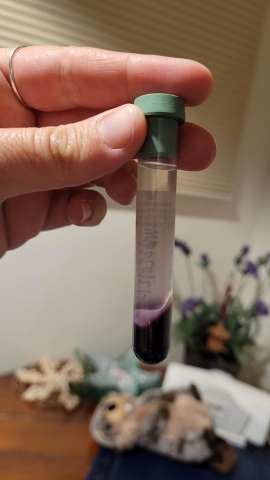
Some of us in the BFL are looking into shark foraging ecology (aka what they eat). While collecting stomach contents tells us what they're eating *right now*, blood and muscle samples can tell us what sharks have been eating up to 12 months ago!
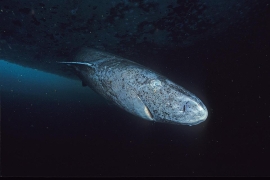
The oldest living vertebrate is a shark! It's thought that Greenland Sharks can live up to 400 years, and only reach sexual maturity at 150 years.
(Julius Nielsen et al. ,Eye lens radiocarbon reveals centuries of longevity in the Greenland shark (Somniosus microcephalus).Science353,702-704(2016).DOI:10.1126/science.aaf1703)
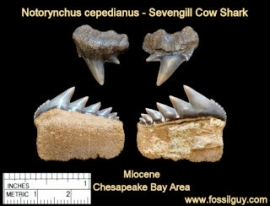
Sevengills are among some of the oldest shark species alive today, and you can still find their fossilized teeth in certain locations such as the Chesapeake Bay area.
(Abel D, Grubbs RD (2020) Shark Biology and Conservation. Johns Hopkins University Press Books)

Salmon sharks and their close relatives, including white sharks, are "regional endotherms". This means that unlike most fish, which are cold-blooded, these sharks can regulate their body temperature and keep warm even in cold waters. For example, the Salmon shark can keep its body temperature up to 12 degrees C higher than that of the surrounding water
(Goldman et al., 2004)
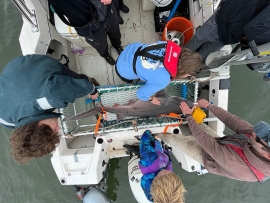
The largest record of the broadnose sevengill was caught in San Francisco Bay, USA – a female measuring at 2.91 m (9.54 ft) and 182 kg (401.2 lbs)
(Ebert D (1989) Life history of the sevengill shark, Notorynchus cepedianus Peron, in two northern California bays. California Fish and Game 75:102–112)
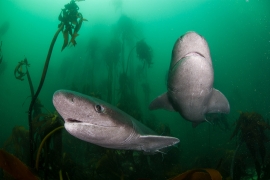
Sevengill sharks are one of five species known to regularly attack cetaceans. The other species include: white, bull, tiger, sixgill.
(Heithaus, M. R. (2001). Predator–prey and competitive interactions between sharks (order Selachii) and dolphins (suborder Odontoceti): a review. Journal of Zoology, 253(1), 53–68. doi:10.1017/s0952836901000061 )

Sharks are literally made of teeth! Their skin is comprised of tiny, tooth-like structures called "dermal denticles"
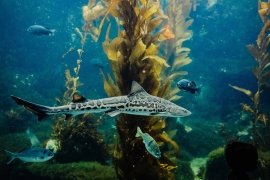
While Leopard sharks (Triakis semifasciata) have an extensive range along the Pacific coast, they aggregate in large numbers in the warm waters along the San Diego coast, with 97.1% of the aggregation being composed of sexually mature and often pregnant females.
(Nosal et al., 2012)
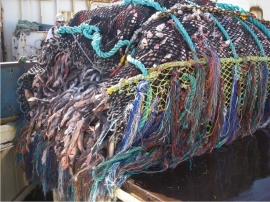
The biggest threat to sharks worldwide is overfishing
(Pacoureau et al., 2023; Sherman et al. 2023)
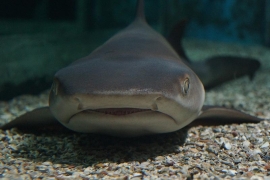
Not all sharks need to "just keep swimming"! Some sharks use buccal pumping to pass water over their gills to ensure that they continue to recieve oxygen while lying on the ocean floor.
(Butler and Metcalfe, 1988)
Before vitamin A was synthesized in a lab Soupfin sharks were harvested for their livers naturally rich in vitamin A. This fishery was highly exploitative and led to the collapse of the Northeast Pacific population.
(Wallace et al., 2007)
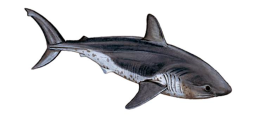
In Russia, salmon sharks are known by a different name, the pacific herring shark, as they are often seen feeding on herring.
(Blagoderov, 1993)
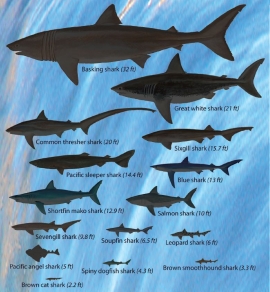
There are 15 shark species native to Oregon waters! These include the Basking Shark, White Shark, Common Thresher Shark, Sixgill Shark, Pacific Sleeper Shark, Blue Shark, Shortfin Mako Shark, Salmon Shark, Sevengill Shark, Soupfin Shark, Leopard Shark, Pacific Angel Shark, Spiny Dogfish Shark, Brown Smoothhound Shark, and Brown Cat Shark.
(Oregon Sea Grant)
Soupfin Sharks exhibit a triennial migration pattern returning to the same warm and sheltered coves to pup every three years
(Nosal et al., 2021)

The Spiny Dogfish shark (Squalus suckleyi) are aptly named for the spines found along both their dorsal fins and their tendancy to hunt in packs and swim in large schools, up to a few thousand!
(NOAA fisheries )

Basking sharks were historically heavily fished in Ireland for the oil in their livers, which was used to light city streets before the advent of electricity
(Went & Súilleabháin, 1966)
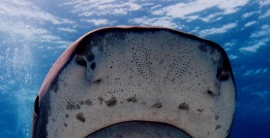
Sharks can detect electrical fields through the use of the Ampullae of Lorenzini, sense organs that form tube like structures under the skin.
(Murray, 1974)
Broadnose sevengills are listed as “vulnerable” globally by the IUCN Red List, with the most recent assessment of the species completed in 2015.
("Jaureguizar AJ, Cortés F, Braccini JM, Wiff R, Milessi AC (2021) Growth estimates of young- of-the-year broadnose sevengill shark, Notorynchus cepedianus, a top predator with poorly calcified vertebrae. Journal of Fish Biology")
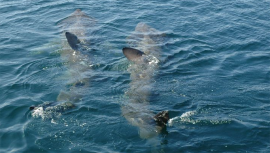
Sharks have friends! There is evidence that multiple species will form non-random associations, preferring to hang out or avoid other specific sharks consistently
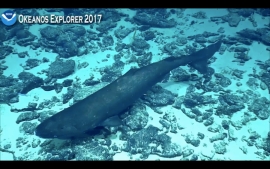
Pacific Sleeper sharks (Somniosus pacificus) they were named for their supposably sleepy, slugglish nature, despite their slow moves their stomach content analysis has indicated that they are adept at feeding on fast moving prey like seals and salmon

The Bluntnose Sixgill (Hexanchus griseus) is one of the larger sharks found off the Oregon coast and they have a distinct diel swimming pattern, often spending time during the day in colder, deeper waters with low oxygen availability.
(Coffey et al., 2020)
